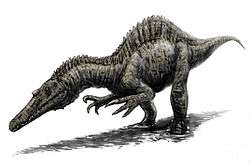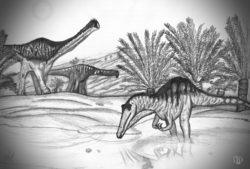Siamosaurus
| Siamosaurus | |
|---|---|
 | |
| Restoration | |
| Scientific classification | |
| Kingdom: | Animalia |
| Phylum: | Chordata |
| Clade: | Dinosauria |
| Order: | Saurischia |
| Suborder: | Theropoda |
| Family: | †Spinosauridae |
| Subfamily: | †Spinosaurinae |
| Genus: | †Siamosaurus Buffetaut & Ingavat, 1986 |
| Species | |
| |
Siamosaurus (meaning "Siamese lizard") is a genus of theropod dinosaur from Barremian Sao Khua Formation in Thailand. The animal is a tooth taxon and therefore details on its size or classification are not certain. The type species, Siamosaurus suteethorni, was formally described by Buffetaut and Ingavat in 1986. It is known from teeth that closely resemble those of Spinosaurus; it may have eaten fish.[1]
Palaeoecology

A 2010 publication by Romain Amiot and colleagues found that oxygen isotope ratios of spinosaurid bones indicates semiaquatic lifestyles. Isotope ratios from teeth from the spinosaurids Baryonyx, Irritator, Siamosaurus, and Spinosaurus were compared with isotopic compositions from contemporaneous theropods, turtles, and crocodilians. The study found that, among theropods, spinosaurid isotope ratios were closer to those of turtles and crocodilians. Siamosaurus specimens tended to have the largest difference from the ratios of other theropods, and Spinosaurus tended to have the least difference. The authors concluded that spinosaurids, like modern crocodilians and hippopotamuses, spent much of their daily lives in water. The authors also suggested that semiaquatic habits and piscivory in spinosaurids can explain how spinosaurids coexisted with other large theropods: by feeding on different prey items and living in different habitats, the different types of theropods would have been out of direct competition. [2]
Phylogeny
The exact position of Siamosaurus within Spinosauridae is difficult to determine because it is only a tooth taxon. However a study by Arden et al. (2018) identified it as a member of the Spinosaurinae.[3]
References
- ↑ Buffetaut, E.; and Ingevat, R. (1986). Unusual theropod dinosaur teeth from the Upper Jurassic of Phu Wiang, northeastern Thailand. Rev. Paleobiol. 5: 217-220.
- ↑ Amiot, R.; Buffetaut, E.; Lécuyer, C.; Wang, X.; Boudad, L.; Ding, Z.; Fourel, F.; Hutt, S.; Martineau, F.; Medeiros, A.; Mo, J.; Simon, L.; Suteethorn, V.; Sweetman, S.; Tong, H.; Zhang, F.; Zhou, Z. (2010). "Oxygen isotope evidence for semi-aquatic habits among spinosaurid theropods". Geology. 38 (2): 139–142. doi:10.1130/G30402.1.
- ↑ Arden, T.M.S.; Klein, C.G.; Zouhri, S.; Longrich, N.R. (2018). "Aquatic adaptation in the skull of carnivorous dinosaurs (Theropoda: Spinosauridae) and the evolution of aquatic habits in Spinosaurus". Cretaceous Research. In Press. doi:10.1016/j.cretres.2018.06.013.

.jpg)
.png)